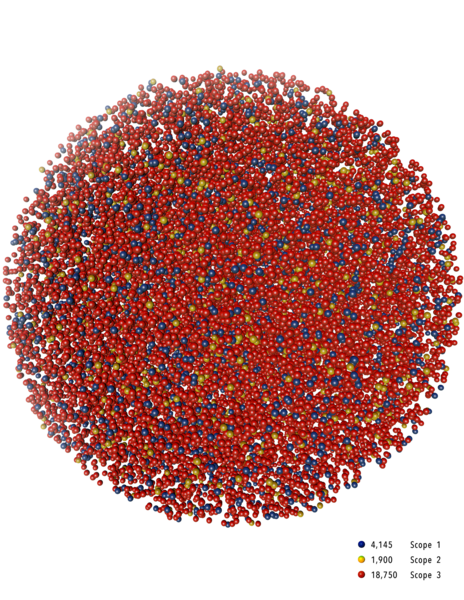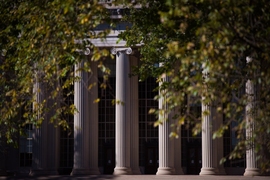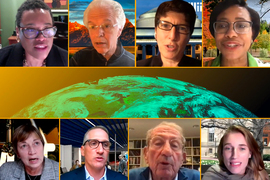The MIT School of Architecture and Planning (SA+P) has announced the adoption of a school-wide climate action plan designed to advance Institute efforts to address climate change and model local-level steps that could be taken throughout MIT.
The plan, endorsed at a Dec. 15, 2020 meeting of the SA+P School Council, presents detailed analysis of SA+P carbon emissions for a single calendar year (2019), and outlines steps to reduce these through changes in procurement, waste tracking, airline travel, and other areas of operation.
The SA+P Climate Action Plan (CAP) articulates the rationale for taking action, develops an analysis for each department, lab, and center within SA+P, and presents a menu of options for action. These actions include goals, commitments, and pilot projects that all aim to reduce the school’s greenhouse gas (GHG) emissions and seed broader campus-wide strategies.
The CAP originated in research undertaken by graduate students in the Department of Urban Studies and Planning (DUSP), with assistance from faculty and the MIT Office of Sustainability (MITOS). Former and current students Yael Nidam MCP '19, Mary Hannah Smith MCP '20, Julia Field MCP '20, and senior Amber Youngeun Kim formed the DUSP Climate group to begin a series of conversations and workshops with faculty, students, staff, alumni, and others to explore what DUSP could do as a department to address climate change.
David Hsu and associate department head Mariana Arcaya, both associate professors, and P. Christopher Zegras, professor and now department head, helped to direct and organize the development of the research. MITOS director and DUSP lecturer Julie Newman and MITOS staff members Jeremy Gregory, Steve Lanou, Stuart Iler, and Brian Goldberg all provided critical data and analysis help.
“Our marvelous students are the true leaders of this initiative,” says Caroline Jones, professor and SA+P associate dean, who guided the effort and helped to build support for the plan throughout SA+P. “As inhabitants of the future, they know how urgent it is to change our behaviors in the present. It was a joy to work with them, and an inspiration to collaborate on our hopes for change.”
SA+P graduate students Ruoming Fang, Kailin Jones, Mariana Medrano, and recent alumnus Diego Hernan Castillo Peredo MCP '20 were among those who contributed additional research and evocative graphics that help readers visualize what a ton of carbon looks like next to a standing human.
Despite the other crises in the world — or perhaps because of them — momentum quickly built throughout the school over the past year. Architecture students formed their own climate group, ClimARCH. Staff at the MIT Media Lab contributed important insights based on their previous efforts on climate.
Jones says that the plan represents an important shift in tone from persuasion (“we should do this”) to conviction (“we now pledge to do this”) and a requirement to undertake cultural changes as well as structural innovation. “The great thing is that research on sustainability and improving our habitation is central to many faculty in the school,” says Jones. “They know how to craft these pilots, gather data, and adapt the goals going forward.”
The plan, as outlined in a report developed in close collaboration with MITOS, will be implemented beginning in fall 2021.
“I am grateful for the dedication of our students and faculty in crafting this plan and putting SA+P at the forefront of research and action on climate issues,” says Hashim Sarkis, dean of SA+P.
Like many universities, MIT centralizes the provision of utilities — electricity, steam, chilled water, and natural gas, as well as phone lines, high-speed internet, data storage, and other energy-intensive services. As a result, individual schools, departments, faculty, and students are often completely unaware of their energy use. Greenhouse gas emissions are highly variable, even within SA+P in the various departments, labs, and centers.
The report thus begins with an analysis of the nature and sources of greenhouse gas emissions from SA+P activities, with reference to the World Resources Institute/World Business Council for Sustainable Development GHG reduction taxonomy of Scopes 1, 2, and 3.
SA+P worked with MITOS to obtain Scope 1, 2, and 3 data, mapping by building, departmental square footage, and consumption activities for the fiscal year 2019, the last year before the coronavirus pandemic.
“The SA+P plan and process is demonstrative of a process that brought students, staff, and faculty together to study and solve for climate change at the school/departmental level. They are setting the stage for the next phase of climate action at MIT by recognizing and grappling with the role of individual and departmental choices that can reduce SA+P and therefore MIT’s greenhouse gas emissions,” says the Institute’s director of sustainability, Julie Newman, a lecturer in DUSP.
The plan outlines opportunities for SA+P to reduce its direct and indirect carbon emissions. It lays out the process to both support and lead the Institute’s efforts toward carbon neutrality.
Implementation will be worked out by departments, labs, and centers and monitored by the school. The initial focus will be on Scope 3 areas, from procurement to waste tracking; a Scope 1 and 2 pilot monitoring energy consumption of the buildings occupied by the school; and the first trials of a Scope 3 carbon tax on travel.
In developing the plan, the students and faculty sought to extend the school’s ongoing research in many areas related to climate change, including resilient net-zero cities, carbon-sequestering building materials, sustainable architecture, transportation, renewable energy systems, sustainable space industries, water infrastructures, restorative landscapes, trash tagging, and tools for personal health or carbon impact tracking.
“Achievements in research inquiry, design, planning, communication, and organizing advance how we think about climate change,” say the plan’s authors. “But now is the time when our specific actions must advance, and not work at cross-purposes with, our scholarship and stated values.”
At the launch of the Plan for Action on Climate Change in 2015, MIT committed to a goal of a 32 percent reduction of Scope 1 and 2 GHG emissions below 2014 levels by 2030. That plan is guided by five pillars to address the global challenge of climate change through research, technology, education, and outreach, as well as calling on MIT to use its campus operations and community as a test bed for change.
At SA+P, it was felt that Scope 3 was a special opportunity for the school to innovate, because MIT has not yet made any commitments in this area, and this category of consumption — waste-based emissions — is especially related to SA+P’s focus on cities and urbanism.
“We believe that SA+P adopting Scope 3 goals can set the standard for how cities should begin this level of action,” states the plan. “Dense cities often congratulate themselves for their relative sustainability based on their energy use on a per-capita or per-area basis, compared to areas that are less densely settled or with fewer industrial or manufacturing activities. However, dense urban areas directly cause GHG emissions by consumption and waste, and this category of GHG emissions is significantly larger for cities than their accounted direct and indirect emissions combined.”
“The most exciting thing about this whole process has been how it has gained momentum so quickly throughout the school and across MIT,” says Hsu. “Everybody wants to know what we should be doing to avoid changing the climate even more. MIT and SA+P are leaders in research and education, but also are our workplace and community. If we can demonstrate how to make changes here, then that’s how we’re going to lead the way, practice what we preach, and do what it takes.”








